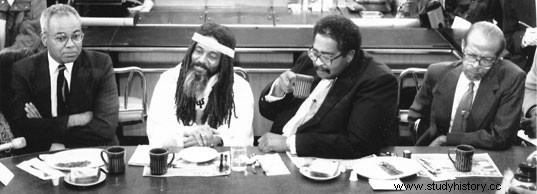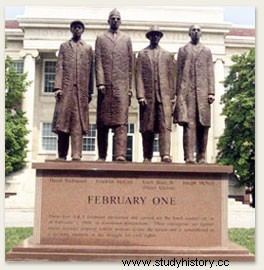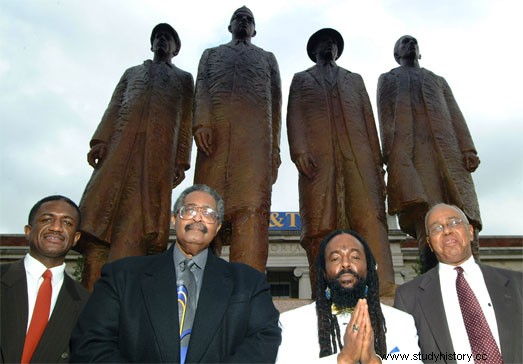It is difficult to understand, now that an African-American resides in the White House and holds the most powerful position in the world, that until relatively few years ago in the United States there was a policy of racial segregation based on regulations such as those known as the Jim Crow Laws, which they established the separation between whites and racial minorities (especially African-Americans) in public spaces such as cafeterias, trains and buses.
Since the second half of the 20th century there had been movements against this segregation, such as the one symbolized by Rosa Parks when in 1955 she refused to give up her seat on the bus to a white man in Montgomery (Alabama). Rosa Parks was arrested and jailed, and civil rights leader Martin Luther King organized a protest and boycott of Montgomery bus lines in support of her. Luther King continued to carry out massive acts in favor of equality between whites and African-Americans, among which the famous march on Washington in 1963 in which he delivered his famous speech in which he immortalized the motto "I have a dream" stands out.
Where it was most difficult, both in fact and in law, to achieve racial integration was in the states that had been part of the Confederacy during the American Civil War. One of these states was North Carolina, in which the town of Greensboro is located and precisely in one of the cafeterias of this city is where the events that give this entry its name took place.
Ezell Blair Jr, David Richmond, Franklin McCain and Joseph McNeil were four young students at North Carolina A&T University, all of them African American. Influenced by the movements led by Martin Luther King and Malcolm X and great followers of Mahatma Gandhi and his form of resistance known as "non-violence", the four young people decided to stage their own form of protest against racial segregation.
For this they chose the Woolworth Cafeteria in Greensboro, known for its policy of serving only whites. On February 1, 1960, the four students entered the cafeteria, sat down and ordered coffee. The waiter refused to serve them, he told them to leave and when they refused he called the police; while it arrived, the customers of the premises uttered all kinds of insults and threats against our protagonists, but the four African-Americans remained seated without responding to the provocations, enduring with great coldness the great tension generated by the verbal aggressions of the indignant white customers of the cafeteria.
The police did not arrive alone, since a white friend of the four students named Ralph Jones had tipped off the newspapers and television stations. In the absence of any provocation on the part of the African-Americans and, most likely, mainly due to the presence of the press, the police were unable to proceed with his arrest. They remained seated without being served until the place closed its doors.
If Woolworth's staff and customers thought the problem was over when the store closed that night, they were sorely mistaken. The next day “the Greensboro Four”, as they became known, returned to the cafeteria, to sit down and ask to be served; again the waiters refused to serve them and again they were rebuked by the local white customers. But the news of what had happened had spread like wildfire, and little by little more African-American students joined them. The scene was repeated day after day and by February 5 the number of students who had joined the protest reached three hundred. The Woolworth cafeteria was overwhelmed and unable to serve customers or serve food.
The echo of the protest initiated by "the Greensboro Four" was reaching a national level and by the end of March there were similar sit-ins by black and white students in fifty-five cities in thirteen states. Some arrests were made, but the national media echo achieved that the objective of the protagonists of the first sit-in was fulfilled and put in the spotlight the policy of racial segregation that a hundred years after the Civil War continued to prevail in many states of the country.
Throughout the summer of 1960, numerous establishments of all kinds in the southern states admitted the presence of African-American clients. The same Woolworth Cafeteria in Greensboro did it almost in secret during the summer vacations of the university students. Taking advantage of the pull created by the symbolic protest of "the Greensboro Four" in North Carolina, the Student Nonviolence Coordinating Committee (SNCC) was founded, which played a prominent role in organizing the 1963 March on Washington and in other famous protests. However, over the years it evolved towards less peaceful positions and ended up dissolving.
But the memory of the brave and symbolic sit-in of "the Greensboro Four" who had the courage to start the movement and endure the humiliation and harassment to which they were subjected during the first days of their protest is still very present as one of the greatest symbols of the fight for the racial integration of African Americans in the United States. In 1990, “the Greensboro Four” celebrated 30 years of their famous deed over coffee…at Greensboro's Woolworth Coffee Shop.

In 2002, at the entrance of North Carolina A&T University, a memorial to their sit-in was inaugurated in the presence of the four protagonists.


Several videos on YouTube collect the story of "the Greensboro Four". I have selected the one that seems most complete to me and that has served as a source for this entry.
